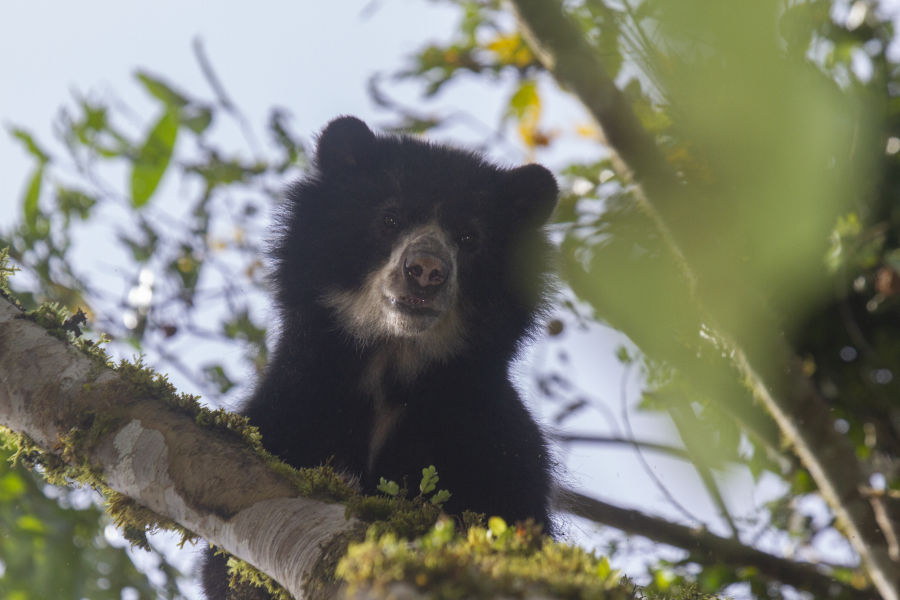Few people will ever get to see Mountain Tapirs or Spectacled Bears, but the Andes are teeming with colorful tropical hummingbirds and tanagers.
If you are looking for great views and photos of colorful, tropical species, there is an extensive network of eserves and dedicated lodges to choose from. The mountains are varied, with the north-south Andean spine splitting into an eastern and west-ern cordillera characterized by different climates and habitats. For instance, the wet outer slopes traditionally are carpeted in forest, up to around 3,400 meters (11,155 feet), above which páramo grasslands take over. However, the valley between is dry in climate, with scattered shrubs and cacti, keeping diversity much lower than the outfacing slopes.
On the highest slopes of the Andes is páramo; a picturesque tundra-like landscape of windswept tussock grasses, with a sprinkling of low shrubs and columnlike Puya bromeliads. This is a stark landscape where life ekes out an existence.


Specialist Bolitoglossa Salamanders creep through the vegetation alongside the Andean Fox and the smallest deer in the world, the incredibly rare Northern Pudu. The páramo is also home to Ecuador’s giant national bird, the Andean Condor, one of the largest flying birds on Earth with a 3.2-meter (10.5-foot) wingspan, while high Andean lagoons host waterbirds like the Andean Teal, Andean Duck, and Andean Gull.
The diverse forests of the Ecuadorian Andes are found in discreet altitudinal bands, with each altitude/forest type having its own characteristic set of animals. This is most clearly seen in the hummingbirds, where species often occupy slim elevational bands, and very narrow niches. For example, the Blue-mantled Thornbill is a páramo specialist, while the Shining Sunbeam and incredible Sword-billed Hummingbird occur just below at the edge between the páramo and the temperate forest. The Collared Inca would indicate the next level of forest down, the subtropical forest.
The subtropical forests is where many spend much of their time wildlife watching in Ecuador, as the lodges sit within extremely rich forests at comfortable climates, lack-ing the chill of the higher forests and the humidity of the lower ones. While the crazy-looking Toucan Barbet and the scintillating scarlet Andean Cock-of-the-rock (rightly) attract a lot of attention, it is always worthwhile keeping an eye on the forest floor for the likes of the Little Devil Poison Frog or an Ocellated Tapaculo.
Finally, wedged between the base of the Andes and the Pacific coast are stretches of deciduous dry forest, and a real hotspot for endemism. The enormous black-handed Guayaquil Squirrel can be seen in these forests, as well as a good number of range-restricted bird species such as the Whooping Motmot and White-edged Oriole.



Ecuador is a great place to see, feel, and photograph the tropics, with a series of very comfortable, wildlife watching-focused hotels and lodges. The country is easy to travel around in and made very accessible with a large team of locally based, highly experienced, English- speaking guides. If you visit Ecuador you are highly likely to get a burning desire to return to these tropical regions, or even Ecuador again, as you can see it has a swathe of possibilities for one-off trips, or return trips too.

Tropical Birding tour leader
Sam Woods
Sam Woods is a full-time professional tour leader for Tropical Birding tours. During his 15 years with the company, he has been based in Quito, Ecuador. Originally from the UK, he has also guided regularly for Tandayapa Bird Lodge, within the Andes of Ecuador. A sighting of a pair of tits (Great and Blue) in a London park changed his life at the age of 11. He was an instant bird junkie, and took a degree in Environmental Science, which led him to the Andes of Ecuador for the first time in order to study hummingbirds. Since graduating, his desire for birding travel really took off, and after joining Tropical Birding, has led him to all 7 continents. He has written articles for the ABA’s Birder’s Guide magazine and other birding magazines, as well as being a co-author on several field guides to Australian birds and wildlife. He was also the primary photographic contributor to the recently published Birds of Western Ecuador: A Photographic Guide.

















